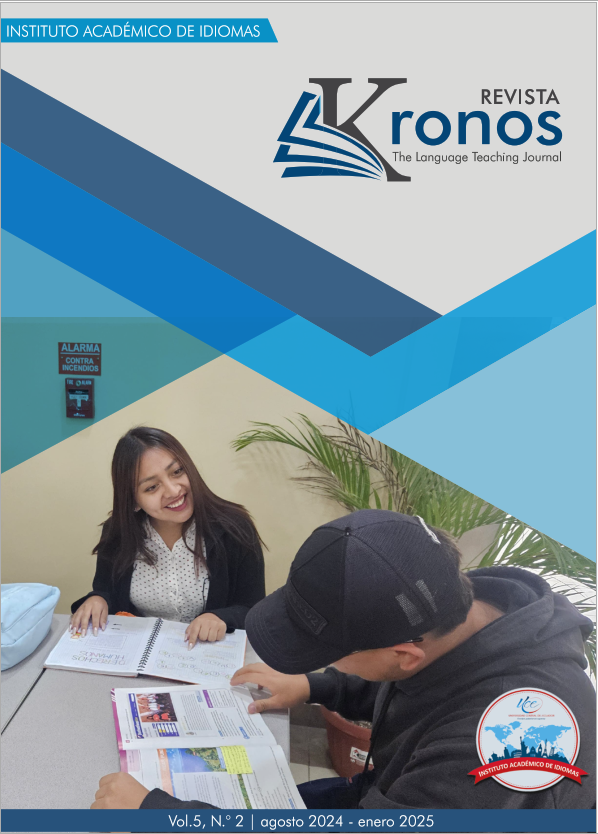The use of Escape Rooms to promote collaboration in English Language Learning among seventh graders
DOI:
https://doi.org/10.29166/kronos.v5i2.7392Keywords:
Escape Rooms, collaborative learning, English language, middle school, EFL, EcuadorAbstract
The present study attempts to establish the effectiveness of escape rooms in achieving an improvement in English language learning among seventh grade students. The study further explores how escape rooms can be used to increase cooperation among students in the language learning process as well as their level of participation. The action research study was conducted from a qualitative approach, benefiting from diagnostic testing, student surveys, an initiative composed of several escape room activities, teacher observation, and final reflection. The results showed that first and foremost, escape rooms have great potential and would act as a means of fostering the pedagogical process by stoking interest and motivation among students as they focus more on communication in the target language than on formal instruction. Escape rooms promote teamwork, communication, and problem-solving skills, but also the actual practice of English, something that is sometimes difficult to achieve in a formal learning environment. The results of the study inform the need to add techniques to foster motivation and collaboration among students. In this way, the use of escape rooms is a great example of techniques that can boost not only cooperation and motivation among students but also significantly improve English language learning, as they must use it to decipher clues and com municate among peers. Furthermore, by carefully considering the various learning styles in the classroom, teachers can design enjoyable and appropriate activities for students' needs and pedagogical goals, overcoming such barriers-
Downloads
References
Almeida, E. (2022). EFL teachers’ understandings of the role of assessment in second lan
guage learning. https://digitalrepository.unm.edu/cgi/viewcontent.cgi?article=1162&
context=educ_llss_etds
Association of College & Research Libraries. (2023). Obtenido de
acrl/ standards
Avison, D. (1999). The Acm Digital Library. Retrieved from https://dl.acm.org/doi/fullHt
ml/10.1145/291469.291479
Dornyei, Z. (2001). Motivational Strategies in the Language Classroom. Cambridge Cambridge DOI: https://doi.org/10.1017/CBO9780511667343
University Press. - References - Scientific Research Publishing. (n.d.). Retrieved October
, 2024 from https://www.scirp.org/reference/ReferencesPapers
Elbæk, L. (2019). ECGBL 2019 13th European Conference on Game-Based Learning. Den
mark.
Figueroa, M., Sánchez, J. F. F., & Pérez, V. M. (2021, June 24). (pdf) Escape Room As A
Motivating Tool In The English Literature Classroom At Tertiary Education. Retrieved
October 14, 2024 from https://www.researchgate.net/publication/367894699_
Escape_Room_As_A_Motivating_Tool_In_The_English_Literature_Classroom_At_
Tertiary_Education
Fleming, N. (2001). Teaching and Learning Styles: VARK Strategies. Neil D. Fleming.
https://books.google.co.id/books?id=K04uyQEACAAJ
Gardner, H., Komhaber, M., y Wake, W. (1996). Intelligence: Multiple
Perspectives. Fort Worth, TX: Harcourt Brace.
Heredia, M. (2024). The use of digital escape rooms for vocabulary acquisition in the
EFL classroom.
Jenkins, H., Clinton, K., Purushotma, R., Robison, A. J., & Weigel, M. (n.d.). Confronting
the Challenges of Participatory Culture: Media Education for the 21st Century.
Johnson, D. W. (2013, January 01). (PDF) Johnson, D. W., & Johnson, R. T. (2013). The im
pact of cooperative, competitive, and individualistic learning environments on achievement. In
J. Hattie & E. Anderman (Eds.), International handbook of student achievement (372-374).
New York: Routledge. Retrieved October 14, 2024 from https://www.researchgate.net/
publication/260596923_Johnson_D_W_Johnson_R_T_2013_The_impact_of_coop
erative_competitive_and_individualistic_learning_environments_on_achievement_
In_J_Hattie_E_Anderman_Eds_International_handbook_of_student_achievement_372
Kolb, A., & Kolb, D. A. (2012). Kolb’s Learning Styles. In N. M. Seel (Ed.), Encyclopedia of DOI: https://doi.org/10.1007/978-1-4419-1428-6_232
the Sciences of Learning (pp. 1698–1703). Springer US. https://doi.org/10.1007/978
-4419-1428-6_228
Lathwesen, C., & Belova, N. (2021). Escape Rooms in STEM Teaching and Learning—
Prospective Field or Declining Trend? A Literature Review. Education Sciences,
(6), Article 6. https://doi.org/10.3390/educsci11060308 Miller, C. L. (2021). Es DOI: https://doi.org/10.3390/educsci11060308
cape Rooms. https://mlpp.pressbooks.pub/gamebasedlearning/chapter/escape-rooms/
Lineamientos-pedagogicos-Sierra-Oriente-2024-2025 .pdf. (n.d.). [PDF]. http://chrome-ex
tension://efaidnbmnnnibpcajpcglclefindmkaj/https://educacion.gob.ec/wp-content/up
loads/downloads/2024/04/Lineamientos-pedagogicos-Sierra-Oriente-2024-2025.pdf
López, A. G. (n.d.). The use of escape rooms to teach and learn English at university - Di
alnet. Dialnet. Retrieved October 14, 2024 from https://dialnet.unirioja.es/servlet/
articulo
Moula, E. E., & Malafantis, K. D. (2020). Save Odysseus: An Escape Room as a Content
Gamification Activity for Enhancing Collaboration and Resilience in the School Con
text. International Journal of Humanities and Social Sciences, 12(2), 1–16. https://doi.
org/10.26803/ijhss.12.2.1
Nunan, D. (1992). Collaborative language learning and teaching.
Oblinger, D. (n.d.). Simulations, Games, and Learning.
Piaget. (1952). In Piaget, Multiple Intelligences (p. 279).
Quichimbo Pesantez, S. K. (2023). Diseño y creación de un escape room como recurso
didáctico para la enseñanza de la geometría en EGB Superior. UCuenca.
Rad, H. S. (2024). Investigating the effectiveness of digital escape rooms in enhancing L2
learners’ vocabulary achievement, retention, and learning motivation.
Yuri Albert, Victor Skersis, Andrey Filippov. Show And Tell. Artist and His Model. (n.d.).
Stella Art Foundation. Retrieved October 14, 2024 from https://en.safmuseum.org/
books/cupid-show-and-tell.html
Published
How to Cite
Issue
Section
License
Copyright (c) 2025 Priscilla Bucciarelli Mena, Evelyn Almeida

This work is licensed under a Creative Commons Attribution-NonCommercial-ShareAlike 4.0 International License.












